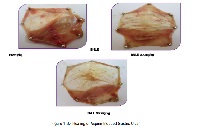Antioxidant and Antiulcer Potential on leaves of Brassica nigra L. against Gastric Ulcer
Keywords:
Brassica nigra L. (Brassicaceae), Gastric ulcer, Pylorus ligation, Antioxidant, Brassica nigra leaf extract (BNLE)Abstract
In the present study, anti-ulcerative effects of extract of Brassica nigra L. leaves were investigated in pylorus ligation and aspirin-induced gastric ulcer models in rats. In present study antiulcer effect of ethanolic extract of Brassica nigra leaves is well understood by total acidity, free acidity, and ulcer index of different groups of animals in both the model viz. Pylorus ligation model & Aspirin induced gastric ulcer in experimental rats when compared the test group with control and standard group. The percentage of ulcer inhibition was observed in pylorus ligated model was as follows: standard, BNLE 100mg/kg, BNLE 200mg/kg and BNLE 300mg/kg 55.76%, 30.96%, 49.54% and 51.35% respectively. The mechanism of gastric ulcer healing is not well understood and further study is needed to evaluate the specific phytoconstituents responsible for the gastric ulcer healing but on the basis of present study it can be concluded that this gastric healing potential may be due to the pharmacological effect played by the different phytoconstituents present in the ethanolic extract of Brassica nigra leaves for prevention of gastric mucosa or by the antioxidant potential of the leaves which is evaluated during the DPPH free radical scavenging activity.
References
. Hoogerwerf WA, Pasricha PJ. Pharmacotherapy of gastric acidity, peptic ulcers, and gastroesophageal reflux disease. In: Brunton, L.L., Lazo, J.S., Parker, K.L. (Eds.), Goodman & Gilman’s The Pharmacological basis of therapeutics, 11th ed. McGraw-Hill Medical Publishing Division, New York, 2006; 967–981.
. Akthar MS, Akthar AH, Khan MA. Antiulcerogenic effects of Ocimum basilicum extracts, volatile oils and flavanoids glycosides in albino rats.International Journal of Pharmacognosy 1992;30, 97–104.
. Repetto MG, Llesuy SF. Antioxidant properties of natural compoundsused in popular medicines for gastric ulcers. Brazilian Journal of Medicaland Biological Research 2002;35, 523–534.
. Dhuley JN. Protective effect of Rhinax, a herbal formulation against physical and chemical factors induced gastric and duodenal ulcers in rats. Indian Journal of Pharmacology 1999;31, 128–132.
. George S, Sathiamoorthy A, Sathiamoorty SS. Effect of alpha tocopherolon gastric ulcers induced by pylorus ligation in rats. Indian Journalof Pharmacology 1999;31, 431–433.
. Goel RK, Sairam K, Anti-ulcer drugs from indigenous sources with emphasis on Musa sapientum, Tamrabhasma. Asparagus racemosus and Zingiber officinale. Indian Journal of Pharmacology 2002; 34, 100–110.
. Khandelwal KR. Practical Pharmacognosy, 11th ed. Nirali Prakashan,Pune, 2004;149–156.
. OECD. Acute oral toxicity. Acute oral toxic class method guideline 423adopted 23.03.1996. In: Eleventh Addendum to the, OECD, guidelines forthe testing of chemicals organisation for economics co-operation, development,Paris, 2002.
. Dharmani P, Mishra PK, Maurya R, Chauhan VS, Palit G. Allolypusserratus: a plant with potential antiulcerogenci activity. Journal ofEthnopharmacology 2005;99, 361–366.
. Gupta M, Mazumder UK, Manikandan L, Bhattacharya S, Senthilkumar GP, Suresh R. Antiulcer activity of ethanol extract of Terminalispallida Brandis. in Swiss albino rats. Journal of Ethnopharmacology 2005; 97,405–408.
. Gibson J. A severity score comprising patient age, ulcer chronicity, and venous refill time predicted venous leg ulcer healing at 24 weeks. Evidence Based Nursing. 2007 Oct 1;10(4):122-.
. Blois M. Antioxidant determination by the use of a stable free radical. Nature 1958;181, 1199–1200.
. Wang GZ, Huang GP, Yin GL, Zhou G, Guo, CJ, Xie CG, et al.,“Aspirin can elicit the recurrence of gastric ulcer induced with acetic acid in rats”, Cell PhysiolBiochem, 2007, page no. 205–212.
. Jainu M, Devi CSS “Gastroprotective action of Cissusquadrangularis extract against NSAID induced gastric ulcer: role of proinflammatory cytokines and oxidative damage”, ChemBiol Interact 2006, page no. 262–270
. Wallace JL. “Prostagrandins, NSAIDs and cytoprotection”,GastroenterolClin North Am, 1992;631–641.
. Brzozowski T, Konturek PC, Konturek SJ, Brzozowska I, Pawlik T. “Role of prostaglandins in gastroprotection and gastric adaptation”, J PhysiolPharmacol , 2005; 33–55.
. Takeuchi K, Ueki S, Tanaka H. “Endogenous prostaglandins in gastric alkaline response in the rat stomach after damage”, Am J Physiol,1986, page no. G842–G849.
Lichtenberger LM. et al. Surface phospholipids in gastric injury and protection when a selective cyclooxygenase-2 inhibitor (Coxib) is used in combination with aspirin. Br J Pharmacol, Volume 150(7), 2007, 913–919.



